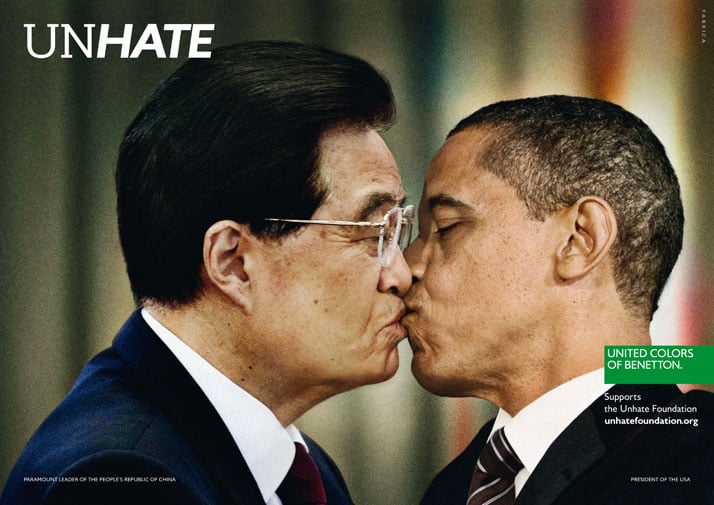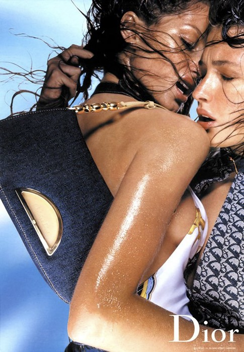During the 2000s, brands directed a lot of daring advertisement which lead them onto the cusp of the controversy. For example, in 1991, since Mauricio Macciori became the advertising director of Diesel, he created the logo that we are familiar with today, but also release the “for successful living” campaign which ran in 89 countries over three years. Diesel has always been seen as a rebellious brand and capable of speaking to gen-z in an authentic and direct way that few other brands can do. This campaign successfully created debate and comment from the public, which made Diesel became the most renowned denim brand and also one of the hottest brand at that time. The adverts were hilarious, controversial but also political, so obviously it had people talking which leading to a dramatical rise in their sales and stockiest.
Benetton was pioneering in pushing the limits of advertising and known of creating controversy and debate through their campaign series. over the years they used daring photograph addressing social issues like environmental issues, terrorism, racism and politics. Benetton was also the first company to eliminate their product completely from its ad campaigns, which means their visibility was mostly increased by their narratives on political or social issues. On 16 November 2011, Benetton launched the UNHATE communication project which include a series of coordinated initiative and events, spread by newspaper, periodicals and website around the world. It is a series of close-up photography of world leaders kissing each other, which include Barack Obama and Chinese leader Hu Jintao; the Palestinian president Mahmoud Abbas and the Israeli prime minister Benjamin Netanyahu. As kissing is the most common expression of love, the executive deputy chairman of Benetton Group, Alessandro Benetton stated that they had decided to give widespread visibility to an ideal notion of tolerance and invite all the citizens of every country to reflect on how hatred arises particularly from fear of ‘the other’ and of what is unfamiliar to the society.
Benetton’s strategy has been called out for “controversy advertising” which refers to encouraging their customer in active participation, debate and communicate with the brand directly. This has lead to a impact to the adverts of shifting their focus on their product to broader social issues ranging from various form of discrimination, homophobia, environmental issues and war to state that the brand are not afraid to take a stand. On sensitive topics. As Oliviero Toscani stated, an Italian photographer worked for Benetton from 1982 till 2000, it is important to “not give the people what they. want but give them what they need”. Many of Toscani’s campaigns have been considered as exploitative on vulnerable group’s pain, but Toscani saw it as an opportunity to shake the current views and belief of social consciousness, to challenge the conservative morals. In the respond to the boycotting and and public anger of the use of shocking imagery, Toscani said“people shouldn’t be shocked by an image, they should be shocked by reality. You should. Be aware that not everyone thinks about shock in the same way that you do.” For him, it is necessary to show global issues through his visual language, “I use photography to express my vision of what’s going on. I am a witness of my time.” Toscani believed that the image would reinforce the “united” message of
Benetton, despite the massive complaint and criticizing from the public, the UNHATE communication project won the Swiss prize from the Société Général d’Affichage, exhibited in Netherlands and became the cover of Benetton’s first magazine, which also bings up the sales and visibility for the brand, proven that they are much more than a retailer and a producer of multicolored sweaters.
Fashion scandals often regarded discrimination trough history. They are caused by actions that the audience perceive as non correct.
scandals can break out because of different forms of discrimination: sexism, homophobia, transphobia, ageism or ableism, for example. A scandal is when a dominant or a privileged group, considered more powerful, is argued to offend and harm a less privileged or a socially vulnerable group.
But sometimes they can go even further for example neurodiversity and mental health.
Quite a few contemporary fashion scandals comes from cultural appropriation issues. There is no problem in using elements from different cultures as source of inspiration.
However the edge of cultural appropriation issues meet between being inspired and stealing. In the recents scandals brands are often accused of misusing and so falling for appropriation of the cultural element. This happens because of a lack of knowledge and sensitivity from the brands in taking inspiration from another culture.
The word “appropriation” has a negative connotation since it is automatically associated to indicate a dominant group that appropriate from a less influent one, for example indigenous communities.
The consumer outrage is a strong negative morally charged reaction from the audience translated in sudden discharge of interventions able to lower the value of the brand. Contemporary scandals can be in part explained by the raise of expectation toward brands to become a better version of them, more diverse, sustainable, environmentally friendly and ethical.
As a result the definition or conception of fashion scandal changed as well changing the whole turn out.
More and more scandals started to strike brands in surprise. Throughout social medias information and voice is no longer controlled by the brand.
To further understand the nature of fashion scandals, Fashion can be visualised as a form of visual communication.
Fashion went through diverse medium-related transformation during history.
The arriving of social media with the “platformization” certainly was big changing factor in the fields of fashion scandals. If on one hand brands can now reach much wider audience, at the same time the audience can now intervene and take action translatable in bad reviews, posts but even boycott and gathering the masses. We can say that this implemented a shifting of power.
Thanks to virtual platforms, mass access interactions with fashion content is now possible gathering informations from individuals to communities now enable to change the nature and the outcome of a fashion scandal. In a sense it has opened up a bit more the closed-up fashion system, by giving voices to the public.
As social medias starts to get bigger and bigger, their impact on the fashion industry rises as well changing the whole mediatization system.
One of the big step of this process happens in the 2010s, the so called “Age of Instagram” increasing exponentially, the weight of platformization in the disruption of fashion communication. Fashion brands even designed shows to be diffused via Instagram.
Instagram is now a hub where space has been given to all the fashion community, from costumers, to retailers, brands, smaller businesses and medias. It plays a capital role in the disruption of fashion communication.
Social medias marked a foundamental step in the direction of a more democratic fashion industry.



